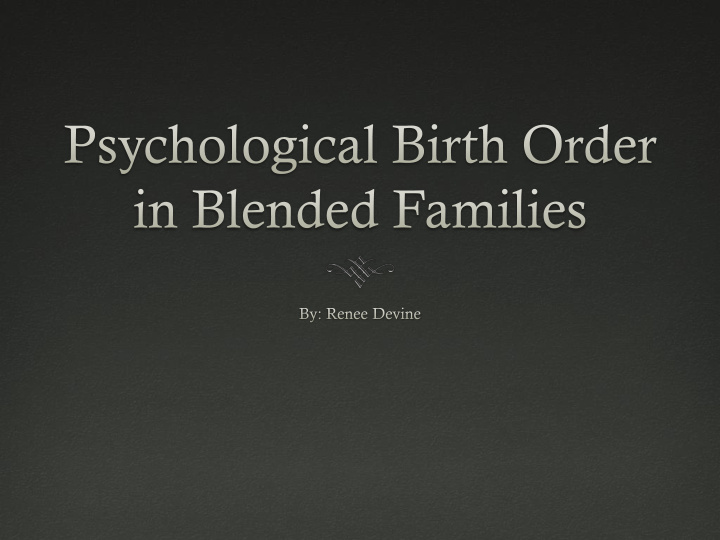



Stepfamily Statistics Approximately one-third of all weddings in the United States today create a stepfamily. It’s predicted that stepfamilies will be the most common family form in the U.S. by the year 2020. An estimated 9,100 new American stepfamilies are created each week. Thirty-three percent of all Americans are in a stepfamily relationship, including an estimated 10 million stepchildren under the age of 18. The divorce rate for remarried and stepfamily couples varies but is at least 60 percent. At least two-thirds of stepfamily couples divorce, and divorce occurs more quickly in stepfamilies than first marriages. About 46 percent of U.S. marriages today are a remarriage for one or both partners, and about 65 percent of remarriages involve children from the prior marriage, thus forming a stepfamily. Source: Stepping In, Stepping Out: Creating Stepfamily Rhythm via Counseling Today article August 30, 2016
Birth Order Position The place in the family based on the situation in which the child is born. This place depends on factors such as number of years between children, disability, and death & miscarriage of siblings. Generally discussed in traditional families. Where an individual falls within their family has some influence on how they form their personality. Ansbacher, 1964
Oldest Child Some time is spent as an Only Child Dethroned at some point – the time spent as an only before dethroned is an important factor in personality Authoritative, Leader Rules and Laws Admire the past & negative outlook toward future Greatest population of problem children Ansbacher, 1964
Second Child Has a pacemaker Often more talented and successful When dethroned, it is not so bad as they have already had to share with another Is a revolutionary / competitive Constant striving to overcome others May be more than one second child Ansbacher, 1964
Youngest Child Never dethroned Has pacemaker(s) Usually passes older siblings Tries to excel in everything Usually spoiled May feel the most inferior Second largest population of problem children Ansbacher, 1964
Only Child Rival is father Pampered or spoiled Center of attention Supported by others yet rules over them Has difficulty sharing when an adult Ansbacher, 1964
Other Sibling Situations Gender differences Cultural implications Physical differences: attractiveness, deformity, organ inferiority, etc. Ansbacher, 1964
Family Constellation Each person has their own place in the family Each person is influenced by the actions of others in the family positive or negative Private logic Parents play an important role Dreikurs, 1992
Changes in Family Death Divorce Abandonment/no contact from biological parent Moving far away from family Changing schools/friends Financial impact
Yours, Mine, Ours Both spouses have children and all children live with them Both spouses have children and only one set lives with them, while the others visit (weekends, holidays, vacations) One spouse has children who live with them One spouse has children who visit (weekends, holidays, vacations) One spouse has children, then spouses have child(ren) together
Who all is involved? Parents & stepparents Siblings & stepsiblings Half siblings Grandparents & step-grandparents All of the above on two sides of family (mom’s/dad’s)
Shuffling the deck Oldest become dethroned….. again! Babies move up in chronological order…. not fair! Onlys have to ……. share?!? And this is at dad’s house, what about mom’s house? Constantly shuffling - instability
The age gap matters If there is a bigger gap in age between sibling sets, the less of an impact it will have on personalities Some exceptions: chauffeuring, babysitting, older sibling influences The closer in age, or blending of ages, the bigger the impact on family dynamics
“Blending” the Family Be honest (within age, and within reason) Discuss changes (together) before they occur Do not expect everyone to be “happy” with the changes There will be bumps in the road, expect them, have a plan for them Regular family meetings Validate feelings & emotions
Feelings Lenaweegreatstart.org Skinnurse.wordpress.com
References Ansbacher, H. L. & Ansbacher, R. R. (1964). The Individual Psychology of Alfred Adler: A systematic presentation in selections from his writings. New York, NY. Harper Perennial. Carlson, J. D., & Robey, P. A. (2011). An Integrative Adlerian Approach to Family Counseling. Journal Of Individual Psychology , 67 (3), 232-244. Dreikurs, R. & Soltz, V . (1992). Children: the challenge: the classical work on improving parent-child relations – intelligent, humane, and eminently practical. New York, NY. Plume. Eckstein, D. (2000). Empirical Studies Indicating Significant Birth-Order-Related Personality Differences. Journal Of Individual Psychology , 56 (4), 481. Eckstein, D., Aycock, K. J., Sperber, M. A., McDonald, J., Van Wiesner III, V ., Watts, R. E., & Ginsburg, P. (2010). A Review of 200 Birth-Order Studies: Lifestyle Characteristics. Journal Of Individual Psychology , 66 (4), 408-434. Eckstein, D., & Kaufman, J. A. (2012). The Role of Birth Order in Personality: An Enduring Intellectual Legacy of Alfred Adler. Journal Of Individual Psychology , 68 (1), 60-74.
References cont’d http://ct.counseling.org/2016/08/behind-book-stepping-stepping- creating-stepfamily-rhythm/ Kluger, J. (2011). The sibling effect: what the bonds among brothers and sisters reveal about us. New York, NY . Riverhead Books. Nelsen, J., Erwin, C., & Glenn, H. S. (2000). Positive Discipline for Your Stepfamily: Nurturing Harmony, Respect, and Joy in Your New Family. Roseville, CA Prima Publishing. Popkin, M. & Einstein, E. (2007). Active Parenting for Stepfamilies: For parents & stepparents. Atlanta, GA. Active Parenting Publishers. Stewart, A. E., & Eckstein, D. (2012). Birth Order Within Individual Psychology. Journal Of Individual Psychology , 68 (1), 1-3.
Contact me: Renee Devine CoachReneeDevine@gmail.com
Recommend
More recommend